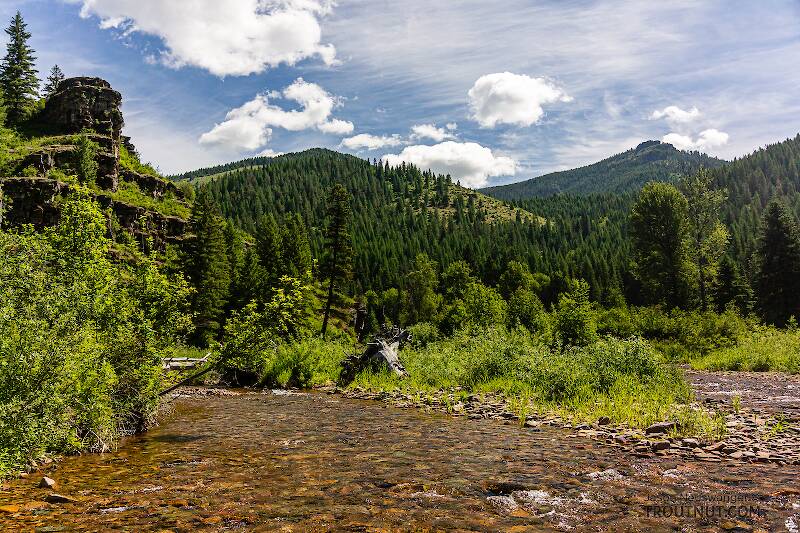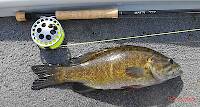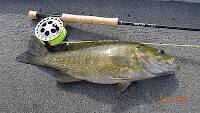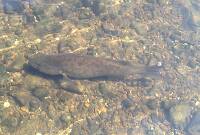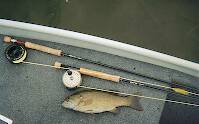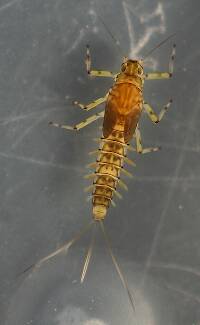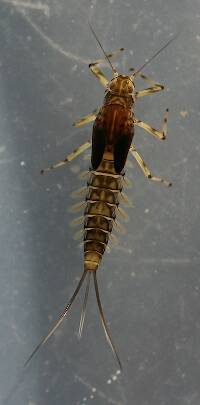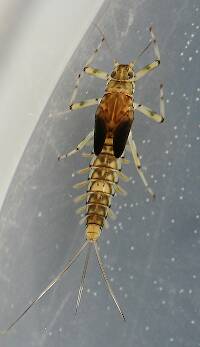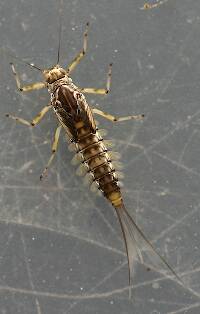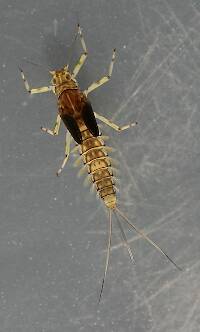
Blue-winged Olives
Baetis
Tiny Baetis mayflies are perhaps the most commonly encountered and imitated by anglers on all American trout streams due to their great abundance, widespread distribution, and trout-friendly emergence habits.
Featured on the forum

I was not fishing, but happened to be at an unrelated social event on a hill above this tiny creek (which I never even saw) when this stonefly flew by me. I assume it came from there. Some key characteristics are tricky to follow, but process of elimination ultimately led me to Sweltsa borealis. It is reassuringly similar to this specimen posted by Bob Newell years ago. It is also so strikingly similar to this nymph from the same river system that I'm comfortable identifying that nymph from this adult. I was especially pleased with the closeup photo of four mites parasitizing this one.

Troutnut is a project started in 2003 by salmonid ecologist Jason "Troutnut" Neuswanger to help anglers and
fly tyers unabashedly embrace the entomological side of the sport. Learn more about Troutnut or
support the project for an enhanced experience here.
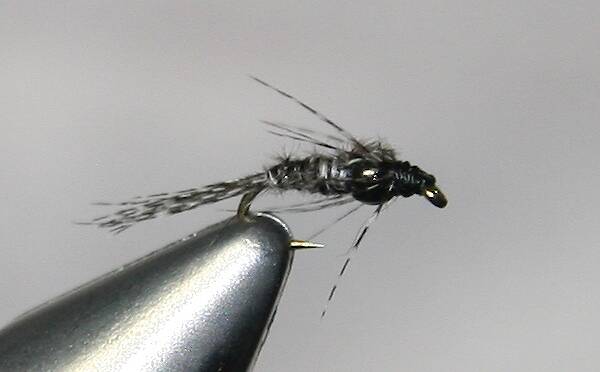
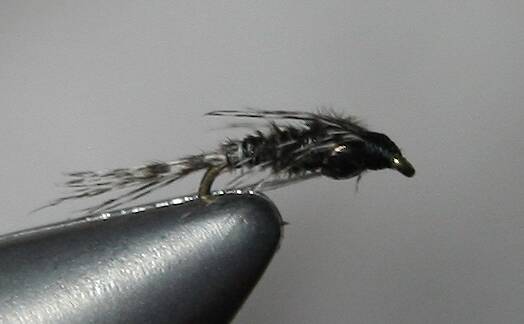
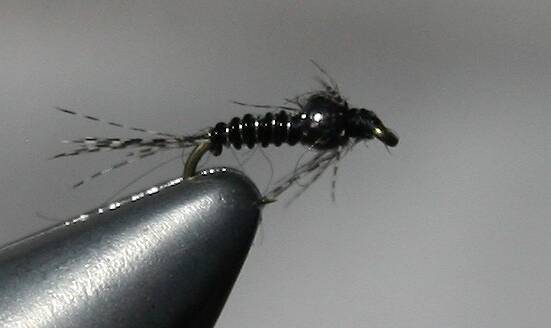
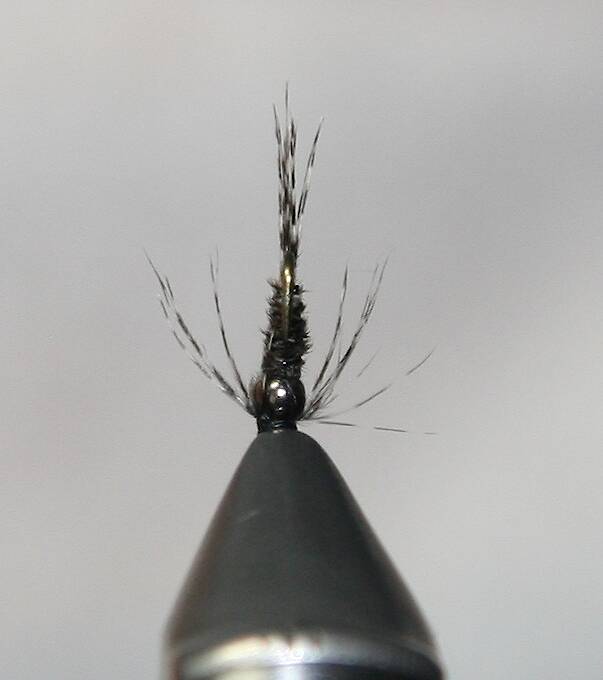
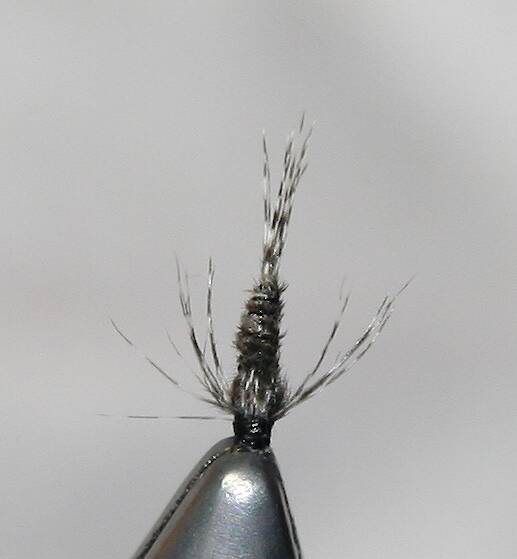
Shawnny3 on Jun 30, 2012June 30th, 2012, 10:01 am EDT
I've been struck lately by how dark the baetis nymphs I've been seining are. I know that the wingpads darken prior to emergence, but the ones I've been seeing lately are almost completely black with transparent mottling, a very dramatic coloration. Last night I sought to mimic this coloration on the bench, and I've come up with some patterns I'm really pleased with. They're all tied in the bead-thorax style I use in many of my small nymphs (the bead is a beautiful gun-metal black - just got 'em). The legs, tails, and wing cases are all tied with dramatically mottled mallard flank. The body of one of them is completely wire (a style I really like), the others use guinea fowl feathers tied as one would pheasant feathers for a Pheasant Tail nymph (another style I really like and is drastically underused, in my opinion - why do people tie PT nymphs in one color and neglect the myriad other feathers there are out there to use? I also tie versions using gray mallard flank, olive mallard flank, and a deep golden woodduck flank). The technique for tying the wing cases and legs is one I'd probably have to show you.
These were tied on a TMC100 hook, Size 24 (which I feel is more like a 22).
-Shawn
These were tied on a TMC100 hook, Size 24 (which I feel is more like a 22).
-Shawn
Jewelry-Quality Artistic Salmon Flies, by Shawn Davis
www.davisflydesigns.com
www.davisflydesigns.com
Martinlf on Jun 30, 2012June 30th, 2012, 10:28 am EDT
Shawn, your flies are always beautiful and creative. My Delaware guide picked one of your style nymphs right out of my box to fish dry dropper, and said what a cool tie. He especially liked the way you put the bead in the thorax area. I gave you credit, though it was hard to.
I use a Tiemco 921 for these little nymphs, and gain a bit more gap. A size 18 gives you the same size shank as a 22 TMC 100. I've also been using Coq de Leon for the tails, and find it a lot more durable than mallard, though stiffer and with less movement. The fish have not complained so far.
I use a Tiemco 921 for these little nymphs, and gain a bit more gap. A size 18 gives you the same size shank as a 22 TMC 100. I've also been using Coq de Leon for the tails, and find it a lot more durable than mallard, though stiffer and with less movement. The fish have not complained so far.
"He spread them a yard and a half. 'And every one that got away is this big.'"
--Fred Chappell
--Fred Chappell
Entoman on Jun 30, 2012June 30th, 2012, 10:47 am EDT
Very nice Shawn! Especially the second and last one. I would also dress a few without the beads as the fish usually key in on them pretty close to the film when they are really working during a hatch. Some species can be extremely slender, so keep that in mind. The variegated pattern you mention could be very helpful in determining the genus and species if you can get them associated with the duns and get photos...
"It's not that I find fishing so important, it's just that I find all other endeavors of Man equally unimportant... And not nearly as much fun!" Robert Traver, Anatomy of a Fisherman
Oldredbarn on Jun 30, 2012June 30th, 2012, 8:12 pm EDT
why do people tie PT nymphs in one color and neglect the myriad other feathers there are out there to use?
Shawn,
Interesting question. I have several pheasant tails dyed in different colors including a rich dark one that's pretty close to your color there, but a very dark brown. I sometimes use dark turkey to wrap the body.
Nice looking bug, buddy! Is that a glass or metal bead?
Spence
"Even when my best efforts fail it's a satisfying challenge, and that, after all, is the essence of fly fishing." -Chauncy Lively
"Envy not the man who lives beside the river, but the man the river flows through." Joseph T Heywood
"Envy not the man who lives beside the river, but the man the river flows through." Joseph T Heywood
Shawnny3 on Jul 1, 2012July 1st, 2012, 5:53 am EDT
Thanks, guys. To your comments:
That's a nice compliment, Louis - thanks for sharing. I hope the fish agreed with his assessment.
Especially with the bead, that's a nice adjustment on flies this small. One problem I have in ordering these specialty hooks is that I don't know what size the shank ends up being. I've ordered size 12s before and ended up with size 6 - really annoying. It would be nice if their size designation had a parenthetical number approximating the bug size you'd likely be tying on the hook. I realize there are flaws with doing that with hooks with strange bends in them, but it would be helpful. I appreciate your giving me a ballpark. Coincidentally, that looks like a good hook to use for other small patterns as well. Is that your go-to hook for the small stuff? (Bracing myself for 6 different hook recommendations...)
I have some beautiful Coq de Leon given to me by a guy from Spain, and I know that it would work really well for these nymphs. Alas, the feathers are so pretty I can't bring myself to cut them up. (The Spaniards are trying, by the way, to change the common name of the bird to "Gallo de Leon" - it bothers them that their chicken has a French name...)
Done. Louis suggested to me that I try making a softhackle version of another nymph I was fishing the other day for that same reason. I tied that up this past week and it has already been quite successful. Perhaps I'll do something similar with this pattern.
Glad to know I'm not the only one. Those sound like nice variations, Spence. I forgot to mention one I tie with peacock herl - I'm going to have to try turkey as well for those really dark ones.
Metal, but not tungsten. I'm usually fishing these in low water. I have tried substituting glass beads for metal in several of my best patterns, both because they're cheaper and because they're less dense (again, for low water). I don't know why (I think they're too bright), but I have not yet developed a pattern with glass that fishes well AT ALL. As soon as I put a glass bead on a pattern, the fish totally ignore it. A shame, because I got giddy at JoAnne's one day and bought them in about 10 different colors.
-Shawn
My Delaware guide picked one of your style nymphs right out of my box to fish dry dropper, and said what a cool tie.
That's a nice compliment, Louis - thanks for sharing. I hope the fish agreed with his assessment.
I use a Tiemco 921 for these little nymphs, and gain a bit more gap. A size 18 gives you the same size shank as a 22 TMC 100.
Especially with the bead, that's a nice adjustment on flies this small. One problem I have in ordering these specialty hooks is that I don't know what size the shank ends up being. I've ordered size 12s before and ended up with size 6 - really annoying. It would be nice if their size designation had a parenthetical number approximating the bug size you'd likely be tying on the hook. I realize there are flaws with doing that with hooks with strange bends in them, but it would be helpful. I appreciate your giving me a ballpark. Coincidentally, that looks like a good hook to use for other small patterns as well. Is that your go-to hook for the small stuff? (Bracing myself for 6 different hook recommendations...)
I've also been using Coq de Leon for the tails, and find it a lot more durable than mallard, though stiffer and with less movement. The fish have not complained so far.
I have some beautiful Coq de Leon given to me by a guy from Spain, and I know that it would work really well for these nymphs. Alas, the feathers are so pretty I can't bring myself to cut them up. (The Spaniards are trying, by the way, to change the common name of the bird to "Gallo de Leon" - it bothers them that their chicken has a French name...)
I would also dress a few without the beads as the fish usually key in on them pretty close to the film when they are really working during a hatch.
Done. Louis suggested to me that I try making a softhackle version of another nymph I was fishing the other day for that same reason. I tied that up this past week and it has already been quite successful. Perhaps I'll do something similar with this pattern.
I have several pheasant tails dyed in different colors including a rich dark one that's pretty close to your color there, but a very dark brown. I sometimes use dark turkey to wrap the body.
Glad to know I'm not the only one. Those sound like nice variations, Spence. I forgot to mention one I tie with peacock herl - I'm going to have to try turkey as well for those really dark ones.
Is that a glass or metal bead?
Metal, but not tungsten. I'm usually fishing these in low water. I have tried substituting glass beads for metal in several of my best patterns, both because they're cheaper and because they're less dense (again, for low water). I don't know why (I think they're too bright), but I have not yet developed a pattern with glass that fishes well AT ALL. As soon as I put a glass bead on a pattern, the fish totally ignore it. A shame, because I got giddy at JoAnne's one day and bought them in about 10 different colors.
-Shawn
Jewelry-Quality Artistic Salmon Flies, by Shawn Davis
www.davisflydesigns.com
www.davisflydesigns.com
Martinlf on Jul 1, 2012July 1st, 2012, 6:52 am EDT
One problem I have in ordering these specialty hooks is that I don't know what size the shank ends up being.
Shawn, for the Tiemco 921's you can subtract two sizes since they are 2X short. A #14 921 is equal to a #18 100, a #16 is equal to a #20 etc. I use the 921 for Baetis dry flies also. Someone else on the site, I think perhaps Joakim (Shanti) also likes the 921 for olives. Along with the Varivas 2300, it's one of my favorite small hooks. For the teeny tinies, I go with the Varivas. Like the 921, it ties two sizes smaller than labeled. So for size 26 Tricos and Baetis such as the Centroptilums I tie mostly on the Varivas #22. The Varivas hooks have a huge gap in comparison to any other dry fly hook I can think of. Only the Daiichi 1640 comes close.
Shawn, can we see that softhackle?
"He spread them a yard and a half. 'And every one that got away is this big.'"
--Fred Chappell
--Fred Chappell
Shawnny3 on Jul 1, 2012July 1st, 2012, 7:24 am EDT
Is that what 2x means in hook designations? I never knew that! Well, that should make things a little easier from now on...
I bought some Tiemco 2488's in Size 28 for the really small guys. I really like the way they look, but I haven't used them yet.
I'll post the softhackle later today.
-Shawn
I bought some Tiemco 2488's in Size 28 for the really small guys. I really like the way they look, but I haven't used them yet.
I'll post the softhackle later today.
-Shawn
Jewelry-Quality Artistic Salmon Flies, by Shawn Davis
www.davisflydesigns.com
www.davisflydesigns.com
Entoman on Jul 1, 2012July 1st, 2012, 7:30 am EDT
Shawn -
I tie derivatives of the PT using turkey tail and dyed mallard flank/pheasant tail for different looks. I usually tie them to original specs, but also versions with legs and thread heads. The general pattern is very versatile and is my "go-to' when the nymphs are speckled or barred. You could use barbules with different markings for different effects. The feathers with the large white dots instead of speckling would be excellent for imitating those abdomens that have the pale segs somewhere along their length.
BTW - I've had similar results with glass beads as well. Excepting a few midge patterns and a caddis pupa (that's really an attractor), I stay away from them.
I tie derivatives of the PT using turkey tail and dyed mallard flank/pheasant tail for different looks. I usually tie them to original specs, but also versions with legs and thread heads. The general pattern is very versatile and is my "go-to' when the nymphs are speckled or barred. You could use barbules with different markings for different effects. The feathers with the large white dots instead of speckling would be excellent for imitating those abdomens that have the pale segs somewhere along their length.
BTW - I've had similar results with glass beads as well. Excepting a few midge patterns and a caddis pupa (that's really an attractor), I stay away from them.
"It's not that I find fishing so important, it's just that I find all other endeavors of Man equally unimportant... And not nearly as much fun!" Robert Traver, Anatomy of a Fisherman
Quick Reply
Related Discussions
Topic
Replies
Last Reply
0
Jan 27, 2017
by Mcflyangler
by Mcflyangler
3
Jan 16, 2007
by Martinlf
by Martinlf
Re: Identification of a possible Cordulegaster Dragonfly Nymph
In Cordulegaster Dragonfly Nymph by IanB
In Cordulegaster Dragonfly Nymph by IanB
6
Feb 10, 2017
by Taxon
by Taxon

